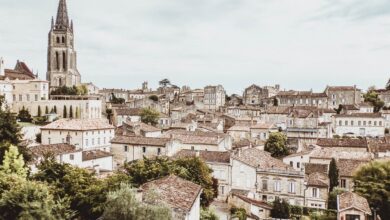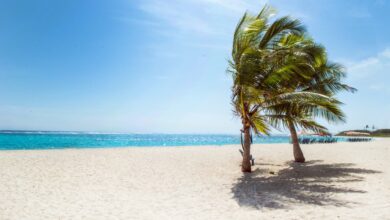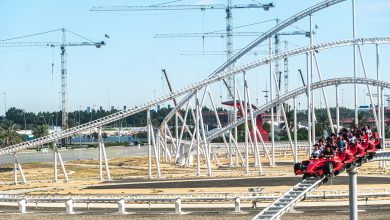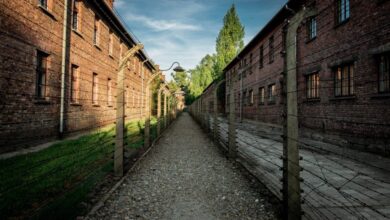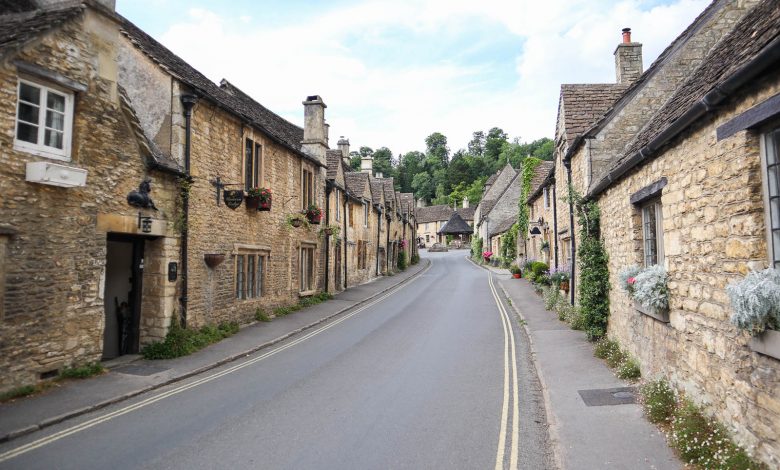
[ad_1]
The Cotswolds is without a doubt one of the most beautiful places in England. Whenever I talk to people who aren’t from the UK they often tell me they visited London but didn’t get to see anywhere else. They’re missing out!
With its flower-covered cottages, babbling brooks and cozy pubs, the Cotswolds is “quintessential” England and definitely worth checking out. Best of all it’s only a 2 hour drive from London, so if you’re visiting from overseas you can easily tag this on to your London itinerary.
If you have the time I’d recommend visiting Bath first if you haven’t already. From there you can drive to the Cotswolds visiting various villages along the way. This route encompasses some of the prettiest ones, plus two of the area’s best attractions – Sezincote House and Cotswolds Wildlife Park.
Part of the experience is actually just driving around. The scenery is breathtaking so even just being in the car and looking out the window is a joy. I did this exact Cotswolds road trip when my friend came to visit from the U.S. and we had an amazing time.
This route takes 2 days and I’d suggest stopping 1 night in the Cotswolds. You could do it all in a day but it would be a mad rush and the whole point of the Cotswolds is to slow down and enjoy a nice B&B experience.
Cotswolds Road Trip Route
Here’s a map of the route I created on Google Maps:
It covers the best places to visit in the Cotswolds including:
- Castle Combe
- Bibury
- Bourton on the Water
- Stow on the Wold
- Seizencote House
- Cotswolds Wildlife Park and Gardens
Where is the Cotswolds?
The Cotswolds is located in south-central England and covers an area of around 787 square miles (2,038 km2). It encompasses a few different counties, including Gloucestershire, Oxfordshire, Wiltshire, Somerset, Worcestershire, and Warwickshire.
The buildings in the towns and villages are made from Cotswold stone, which is characterized by its golden color. The stone is a type of oolitic limestone that’s abundant in the area and mainly quarried in the Cotswold Hills.
You may notice that the Cotswolds often has “AONB” on the end – these four letters mean ‘Area of Outstanding Natural Beauty’. The region received this designation in 1966.
Best Places to Visit on Your Cotswolds Road Trip
Now that I’ve given you a little intro, let’s take a look at the best places to visit on your Cotswolds road trip:
Castle Combe
Often named ‘the prettiest village in England’, Castle Combe is one of the first villages you’ll come across if you’re driving from Bath. The village lies 5 miles northwest of Chippenham and it’s one of the best spots for taking photos in the Cotswolds.
The village has been used as a backdrop for numerous films, including The Wolf Man, Stardust and Stephen Spielberg’s War Horse.
Once you’ve parked (the car park is called West St), wander through the village to the bridge and snap some photos. Within the town there’s a church called St Andrew’s Church which dates back to the 13th century, plus a pub, a coffee shop and a luxury manor hotel with golf course.
Some of the residents leave water and snacks outside their homes for tourists to purchase – they just ask that you leave the money inside their letterbox.
Points of interest in Castle Combe:
- The Giant Sequoia
- Bridge at Water Lane
- The Manor House
- St. Andrew’s Church
- The Castle Inn
- The White Hart
- The Old Stables Coffee Shop
Bibury
From Castle Combe, the drive to Bibury takes around 50 minutes. This is another small village often cited as one of the most picturesque villages in England.
The main focal point is Arlington Row, which is one of the most photographed streets in the Cotswolds. The building dates back to the 1380 and was once a monastic wool store, but was converted into a row of weaver’s cottacges in the 17th century.
Through the center of the town flows the River Coln, with the main street on one side and a boggy water meadow called Rack Isle on the other.
Highlights of the town include:
- St. Mary’s Church, which features a beautiful stained glass window
- Bibury Trout Farm
- Arlington Row
- The Swan Hotel, which is covered with green foliage
Bourton on the Water
A 20 minute drive from Bibury you’ll find Bourton on the Water, which is home to a few interesting attractions including the Cotswold Motoring Museum, Birdland and The Model Village. Known as ‘the Venice of the Cotswolds’, Bourton on the Water is known for its tranquil river and five low bridges, similar to those in Venice.
If you enjoy walking then you’ll find plenty of footpaths here, since many of them start, end or pass through Bourton on the Water. The town itself can get rather crowded in peak season and when we visited we found it to be the busiest place village we came across.
Top things to do in Bourton on the Water:
- Cotswold Motoring Museum – houses a collection of vintage cars and toys
- Cotswold Brewing Company – A family owned and operated brewery, brewing modern craft keg beers. Guests can take a tour of the brewery and sample the beers on tap
- Birdland Park and Gardens – home to exotic birds including King penguins, flamingos, macaws and emus
- The Model Village – a 1/9th scale replica of Bourton on the Water
Stow on the Wold
Once you’ve visited Bourton on the Water, make the short trip to neighbouring Stow on the Wold. This market town is the highest town in the Cotswolds, standing 800 feet-high on Stow Hill, at a junction of seven major roads. Walking through the town you’ll discover lots of antique shops, art galleries, gift shops, tea rooms and pubs.
Stow on the Wold used to host some of the country’s largest sheep fairs, with up to 20,000 sheep up for sale in any one day.There are no longer any sheep fairs held here but there’s a farmer’s market that takes place in the main square on the 2nd Thursday of each month.
Notable things to see in Stow on the Wold include:
- The Old Stocks Inn (oldest inn in England)
- St Edwards church
- Market Cross
- Historic Village Stocks
- Cricket Museum
Sezincote House
Sezincote House is an Indian palace set in the Cotswold Hills about a 15 minute drive north from Stow on the Wold. Designed by Samuel Pepys Cockerell and built in 1805, the house was made using stone from a nearby quarry and is an excellent example of Neo-Mughal architecture.
In case you’re wondering how an Indian palace came to exist in the middle of the English countryside; a man called Colonel John Cockerell bought Sezincote estate in 1795 on his return from Bengal where he had worked for the East India Company.
After his death his youngest brother Sir Charles Cockerell inherited the property and asked his other brother to design a house in an Indian style. Samuel had never been to India but he studied Mughal architecture through drawings and engravings.
The house is impressive and is set amongst a landscape of grottoes, temples, waterfalls and canals. The exterior of the building is orange in color, with a green onion shaped dome on top. The gardens here are beautiful and there are two elephants that frame the view of the house.
Today the estate is family-run and the estate hosts six weddings per year. Visitors can pay to enter the gardens or buy a ticket to join a tour of the house.
Cotswolds Wildlife Park and Gardens
I’m not a fan of many zoos and I much prefer wildlife parks where the animals can roam around with a lot more space. Cotswolds Wildlife Park and Gardens is set in over 160 acres of parklands and is divided into four areas, which each have their own team of keepers to take care of the animals.
It’s not quite a safari park because you park your car before entering but it definitely doesn’t feel like a zoo either. The enclosures are well landscaped and very spacious. It’s a beautiful park and it feels like you’re on a walking safari due to the lack of obtrusive fencing.
Within the park you’ll have the chance to view a wide variety of mammals, including Asiatic lions, meerkats, camels, wolverines, sifakas, lemurs and zebras. You’ll get to see eye-to-eye with a giraffe on the Giraffe Walkway and see rhinos grazing on the Manor House lawns.
The park is also home to 93 species of birds, including black storks, penguins and ostriches. The reptile collection includes green anacondas, lizards, frogs and invertebrates.
Adult tickets cost £17.50 on the door or £16 online. Children’s tickets (age 3-16) cost £12 on the door and £11 online. Children under the age of 2 enter for free.
Getting Around the Cotswolds
To get around the Cotswolds you ideally need a vehicle. Yes you can take the train to some of the major towns but you’ll find it more complicated to get to some of the smaller villages.
Renting a car – The easiest way to get around the Cotswolds. If you’re coming from London and you don’t have your own car, you can rent a car in the city or from one of the airports. Or you could rent a car from Bath and start your journey there. Check out Rentalcars.com or Kayak for prices.
By public transportation – If you don’t want to rent a car or you can’t drive then you could take a train to one of the main towns. Once you’re in The Cotswolds you’d need to get around with a combination of taxis, trains and local buses. A Lady in London wrote a good guide to getting around The Cotswolds without a car.
Where to Stay in the Cotswolds
The Court House Manor – We stayed at The Court House Manor in Painswick, which dates back to the 15th century and functioned as a court house until 1931. In fact King Charles 1 once stayed there prior to the Siege of Gloucester in 1643. It’s a little out of the way from the road trip route I’ve just listed but it’s a really gorgeous and manor with amazing views. The rooms are luxurious and the free hot breakfast was a good way to start the day. I booked it last minute on Hotel Tonight and was definitely happy with my choice.
Your FAQs About the Cotswolds, Answered
Castle Combe is often called the prettiest village in England. On my road trip through the Cotswolds I found Castle Combe and Bibury to be the two prettiest villages in the region.
There’s no main town per se. The Cotswolds has many towns and villages. The largest one is the market town of Cirencester, which is sometimes nicknamed the ‘The Capital of the Cotswolds’.
The name Cotswolds means “sheep enclosure in rolling hillsides”. It’s based on two very old English terms. ‘Wolds’ are gentle hills while ‘Cots’ are sheep enclosures. So the name is basically a description of the landscape in the area.
The Cotswolds is known for being an area of outstanding natural beauty.
Being such a beautiful place, the Cotswolds attracts a number of celebrities, some of whom have bought homes there. Celebrities who reportedly own homes in the Cotswolds include Kate Winslet, Liz Hurley, David and Victoria Beckham, Jeremy Clarkson, Laurence Llewelyn-Bowen, Jamie Dornan and Kate Moss.
There are five counties that fall within the Cotswolds AONB, including Gloucestershire, Oxfordshire, Warwickshire, Wiltshire and Worcestershire.
A Final Word…
Whether you’re visiting from overseas or you’re from the UK and you’ve just never been there, a visit to the Cotswolds is an absolute must. There’s a reason it was designated an area of Outstanding Natural Beauty! If you follow this Cotswolds road trip route I’m pretty confident you’ll enjoy your time there.
[ad_2]
Source link



